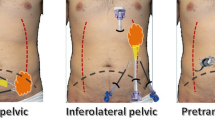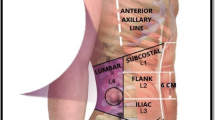Abstract
Purpose
Lateral abdominal wall hernias are rare defects but, due to their location, repair is difficult, and recurrence is common. Few studies exist to support a standard protocol for repair of these lateral hernias. We hypothesized that anchoring our repair to fixed bony structures would reduce recurrence rates.
Methods
A retrospective review of all patients who underwent lateral hernia repair at our institution was performed.
Results
Eight cases (seven flank and one thoracoabdominal) were reviewed. The median defect size was 105 cm2 (range 36–625 cm2). The median operative time was 185 min (range 133–282 min). There were no major complications. One patient who was repaired without mesh attachment to bony landmarks developed a recurrence at ten months and subsequently underwent reoperation. Patients with mesh secured to bony landmarks were recurrence free at a median follow-up of 171 days.
Conclusions
Lateral hernias present a greater challenge due to their anatomic location. An open technique with mesh fixation to bony structures is a promising solution to this complex problem.



Similar content being viewed by others
References
Dietz UA, Menzel S, Lock J, Wiegering A (2018) The treatment of incisional hernia. Deutsches Aerzteblatt. https://doi.org/10.3238/arztebl.2018.0031
Baumann DP, Butler CE (2012) Lateral abdominal wall reconstruction. Semin Plast Surg 26(1):40–48. https://doi.org/10.1055/s-0032-1302465
Stamatiou D, Skandalakis JE, Skandalakis LJ, Mirilas P (2009) Lumbar hernia: surgical anatomy, embryology, and technique of repair. Am Surg 75(3):202–207
Moreno-Egea A, Baena EG, Calle MC, Martinez JA, Albasini JL (2007) Controversies in the current management of lumbar hernias. Arch Surg 142(1):82–88. https://doi.org/10.1001/archsurg.142.1.82
Macchi V, Porzionato A, Morra A, Picardi EEE, Stecco C, Loukas M, Tubbs RS, De Caro R (2016) The triangles of Grynfeltt and Petit and the lumbar tunnel: an anatomo-radiologic study. Hernia. https://doi.org/10.1007/s10029-016-1509-3
Wigley J, Noble F, King A (2014) Thoracoabdominal herniation but not as you know it. Ann R Coll Surg Engl 96(5):e1–e2. https://doi.org/10.1308/003588414x13814021679032
Standring S (2015) Gray's anatomy E-book: the anatomical basis of clinical practice. Elsevier Health Sciences, Amsterdam
Gardner GP, Josephs LG, Rosca M, Rich J, Woodson J, Menzoian JO (1994) The retroperitoneal incision. An evaluation of postoperative flank 'bulge'. Arch Surg 129(7):753–756
Dakin GK, Kendrick ML (2013) Challenging hernia locations: flank hernias. The SAGES manual of hernia repair. Springer, Berlin, pp 531–540
Beffa LR, Margiotta AL, Carbonell AM (2018) Flank and lumbar hernia repair. Surg Clin North Am 98(3):593–605. https://doi.org/10.1016/j.suc.2018.01.009
Veyrie N, Poghosyan T, Corigliano N, Canard G, Servajean S, Bouillot JL (2013) Lateral incisional hernia repair by the retromuscular approach with polyester standard mesh: topographic considerations and long-term follow-up of 61 consecutive patients. World J Surg 37(3):538–544. https://doi.org/10.1007/s00268-012-1857-9
Stumpf M, Conze J, Prescher A, Junge K, Krones CJ, Klinge U, Schumpelick V (2009) The lateral incisional hernia: anatomical considerations for a standardized retromuscular sublay repair. Hernia 13(3):293–297. https://doi.org/10.1007/s10029-009-0479-0
Halm JA, Lip H, Schmitz PI, Jeekel J (2009) Incisional hernia after upper abdominal surgery: a randomised controlled trial of midline versus transverse incision. Hernia 13(3):275–280. https://doi.org/10.1007/s10029-008-0469-7
Greenall MJ, Evans M, Pollock AV (1980) Midline or transverse laparotomy? A random controlled clinical trial. Part II: Influence on postoperative pulmonary complications. Br J Surg 67(3):191–194
Kendall SW, Brennan TG, Guillou PJ (1991) Suture length to wound length ratio and the integrity of midline and lateral paramedian incisions. Br J Surg 78(6):705–707
Moreno-Egea A, Carrillo A, Aguayo JL (2008) Midline versus nonmidline laparoscopic incisional hernioplasty: a comparative study. Surg Endosc 22(3):744–749. https://doi.org/10.1007/s00464-007-9480-9
Phillips MS, Krpata DM, Blatnik JA, Rosen MJ (2012) Retromuscular preperitoneal repair of flank hernias. J Gastrointest Surg 16(8):1548–1553. https://doi.org/10.1007/s11605-012-1890-x
Heniford BT, Iannitti DA, Gagner M (1997) Laparoscopic inferior and superior lumbar hernia repair. Arch Surg 132(10):1141–1144
Blair LJ, Cox TC, Huntington CR, Ross SW, Kneisl JS, Augenstein VA, Heniford BT (2015) Bone anchor fixation in abdominal wall reconstruction: a useful adjunct in suprapubic and para-iliac hernia repair. Am Surg 81(7):693–697
Pezeshk RA, Pulikkottil BJ, Bailey SH, Schaffer NE, Reece EM, Thornton NJ, Gupta AR, Hoxworth RE (2015) An evidence-based model for the successful treatment of flank and lateral abdominal wall hernias. Plast Reconstr Surg 136(2):377–385. https://doi.org/10.1097/PRS.0000000000001432
Zhou DJ, Carlson MA (2018) Incidence, etiology, management, and outcomes of flank hernia: review of published data. Hernia 22(2):353–361. https://doi.org/10.1007/s10029-018-1740-1
Author information
Authors and Affiliations
Corresponding author
Ethics declarations
Conflict of interest
The authors declare that they have no competing interests.
Ethical approval
All procedures performed in studies involving human participants were in accordance with The ethical standards of the institutional and/or national research committee and with the 1964 Helsinki declaration and its later amendments or comparable ethical standards.
Human and animal rights
This study does not include any animal trial.
Informed consent
For this type of article, informed consent is not required.
Additional information
Publisher's Note
Springer Nature remains neutral with regard to jurisdictional claims in published maps and institutional affiliations.
Rights and permissions
About this article
Cite this article
Katkhouda, N., Alicuben, E.T., Pham, V. et al. Management of lateral abdominal hernias. Hernia 24, 353–358 (2020). https://doi.org/10.1007/s10029-020-02126-5
Received:
Accepted:
Published:
Issue Date:
DOI: https://doi.org/10.1007/s10029-020-02126-5




